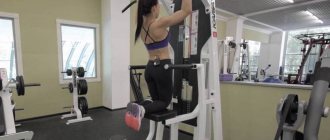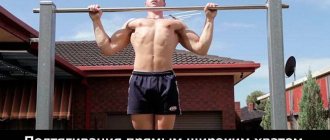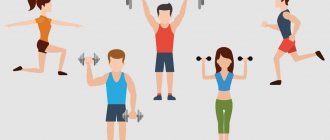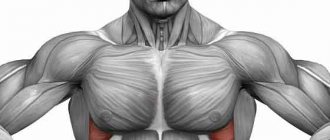What kipping pull-ups are is already clear from the name. True, only for those who know English well and are interested in CrossFit. Among other meanings, “kip” can also be translated as “kip up.” It is this phrase that explains the principle of this exercise. Kipping pull-ups differ from regular pull-ups in that the body is lifted by swinging the legs simultaneously with flexion and extension of the body. Thanks to this technique, pulling up is easier, because the overall load on the arm muscles is reduced. At the same time, the body spends the same amount of energy as during a regular pull-up. This happens due to the fact that other muscles work more actively.
What are kipping pull-ups?
Kipping pull-ups are a type of pull-up in which your hips and legs swing and use momentum to help you pull yourself up. This significantly reduces the load on your hands.
There is also an advanced version called the butterfly pull-up, which uses constant motion to produce even faster pull-ups. In this case, a larger array of muscles and movement impulse are used to move the body in space.
For competitive CrossFitters, kipping helps them get more reps in less time. This does not violate the rules of their sport in any way, so for them it is quite an exercise. Well, for guys who want to gain more “meat” and increase strength, should they do this exercise? Is it safe? And most importantly, do you need to learn how to do it?
Kipping pull-ups: pros and cons
Such pull-ups are suitable exclusively for athletes in the CrossFit discipline, since this technique does not imply quality and concentration, but quantity and speed of execution.
Pros:
- This exercise is a great way to train explosiveness, coordination, and grip strength.
- It is an intermediate or auxiliary exercise for mastering more complex techniques, such as lifting with an inversion or power-up.
- During the execution of movements, most of the muscles of the body are involved in the work.
The disadvantage of this type of pull-ups is that there is a large load on the ligaments and joints, and accordingly, there is an increased likelihood of injury. That is why kipping should not be used by athletes whose number of push-ups is less than or equal to ten.
Kipping and pressing "shvung"
Kipping is related to a strict pull-up in the same way that a push press is related to a “military” press.
In both the kipping and push press, you use the momentum created by the lower body to assist the movement of the upper body. That is, the stronger the impulse you give with your lower body, the easier it will be for your upper body. And it will be easier to lift more weight or do more repetitions.
So is the shwung press a cheating or a type of bench press? One thing I am sure of is that in both cases, the person performing these exercises will either look super athletic, focused and powerful, or they will look like they are having a seizure.
I really like the high snatch, which is very similar to the kipping pull-up: you use your lower body to create as much momentum as possible so you don't have to strain your arms as much. Am I cheating too?
Mistakes when performing butterfly pull-ups
- loss of inertia due to the entire body being pushed forward
- weak swing as a result of which pull-ups are performed using the force of the arms
- legs bend at the knees when pulled back
Kipping is not cheating
A true kipping pull-up is not just a cheat pull-up. This is a fairly complex technical movement. The correct kipping technique requires the athlete to have endurance, strength and coordination. Especially when performing several pull-ups in a row (that is, without a pause in the bottom position between repetitions), and all these qualities are needed even more when performing the butterfly.
The same can be said about the press “shvung”. This is not just a “military” bench press with cheating. A very precise movement that requires a certain body position and good endurance. You need to use your hands at the right moment - not earlier, not later.
Few people criticize the push-up press; so far, kipping pull-ups receive more angry letters. And it's strange. In both cases, you do one thing - use momentum to help your upper body complete the rep.
When we talk about these exercises, we're talking about compound movements. In two cases, those who do them incorrectly will appear epileptic and increase the risk of injury. But if both pull-ups are done correctly, then they are safe.
Maybe it’s because kipping was popularized by crossfitters, and the push press by weightlifters? It seems to me that now every hardcore poser feels obligated to hate CrossFitters. Although for me there is no difference. Anyway, I'm not saying that CrossFit kipping pull-ups are a good exercise and everyone should do them. Also, I’m not saying that the push press can and should be done by everyone without exception.
History of the bale
Kipping pull-ups were designed to achieve the required number of unbroken reps faster than an athlete who would do strict pull-ups. In fact, people in gyms have been doing them for quite a long time, but they were not called kipping, but simply pull-ups with a slight rocking of the pelvis.
When CrossFit competitions began, the rules for pull-ups stated that the athlete must somehow get his chin over the bar. Coming out of this, cheating pull-ups were allowed. And athletes who manipulated the rules to achieve maximum advantage developed the more complex kipping pull-ups we see today.
Nowadays, you will rarely see an athlete at a CrossFit competition who chooses to do “strict” pull-ups, especially if the routine does not indicate this. At first, kipping pull-ups didn't bother anyone, since they were only performed by top-level athletes who can do a ton of strict pull-ups. Kipping simply helped them finish their WOD faster.
They were made by athletes who had well-developed muscles around the shoulder joint. These muscles could absorb the pressure created by performing kip pull-ups.
Problems appeared when CrossFit went mainstream. Very often, beginners do not have the muscle corset and shoulder mobility to perform kipping pull-ups safely. But what caused the real problems was that even those who were quite weak (individuals who could not do one or two strict pull-ups) could do kipping pull-ups once they learned proper pelvic movement.
But even if you can do it, doesn't mean you should!
Let's go back to the comparison with the push press. If someone is weak and can't hold a 30kg barbell over their head without looking like they're lifting in an earthquake, then they probably shouldn't be allowed to do push presses.
Of course he will be able to lift the barbell over the head thanks to the push of the legs, but the possibility of injury will be high due to the catastrophe that can occur in trying to hold the barbell. Likewise, a person who cannot do strict pull-ups will do kipping.
Extrastrong – Strength training, Fitness and bodybuilding, Increasing muscle mass
21.01.2014
Why don't I recommend doing jerky pull-ups ?
Anatomy, rotator cuff muscles
To illustrate, here's a series of pictures taken from a cool app called Essential Anatomy 2 (you can buy it in the app store for $30). The first picture shows three of the four rotator cuff muscles . Let's list them from top to bottom: supraspinatus muscle (located above the crest of the scapula), infraspinatus muscle (located below the crest of the scapula), teres minor (runs from the scapula to the shoulder, is responsible for supination of the shoulder).
The following picture shows the fourth rotator cuff muscle, the subscapularis (note that it is located in front of the shoulder blade, while the others are behind it).
Shoulder joint structure, anatomy
Next, the structure of the shoulder joint, or as it is also called the glenohumeral joint, is examined in more detail.
Skeleton, shoulder joint
Here all the muscles are removed, exposing the tendons, joint capsule and ligaments.
Shoulder joint, tendons, joint capsule, ligaments
In the following figure, the joint capsule is highlighted in green. No, it's not actually green. It is a very loose membrane around the head of the humerus that connects the humerus and scapula.
Shoulder joint, anatomy. The joint capsule is highlighted in green.
In the last picture, everything is removed except the humerus, scapula and the joint attachment, which are highlighted in green.
Skeleton, anatomy. The shoulder joint, where the joint attaches, is highlighted in green.
So let's move on to the explanation. You have several devices that form the shoulder (ligaments, joint capsule, bones, etc.) It is the muscles that rotate the shoulder, and not some idea or something intangible. The humerus connects to the scapula through four muscles. And these muscles can be trained. The muscles that are responsible for rotating the shoulder can be well strengthened through proper training. The barbell up press is one such method. Another way is pull-ups. As well as all kinds of isolation exercises.
And finally, the labrum. It is a small frame (in the form of a ring) made of cartilage, which increases the gripping articular surface, forming a small fossa. The glenoid fossa is located under the labrum and forms a small round part within it. The smooth surface of the head of the humerus articulates (connects) with the scapula through the glenoid fossa. It's pretty obvious that the hole isn't very deep. It doesn't even wrap around the head of the humerus. Thus, the labrum is that small addition that helps the bones connect, the connection also involves ligaments, tendons, the four previously mentioned rotator cuff muscles, and even some of the large muscles that are responsible for moving the arm (for example, the deltoid shoulder muscle ).
So how can you damage this little labrum? Many CrossFitters have experienced this, and there are several articles online that address it. Careless exercise technique , a large number of exercises themselves (as well as a large number of approaches in one exercise) can lead to injuries: muscle strain, ligaments and tumors. Look at your shoulder. It consists of three bones. And it has many different parts that are intertwined with each other.
From my experience, I can say that jerk pull-ups are the most traumatic for the labrum. I am by no means a professional or a physical education teacher, but an amateur trainer studying strength, which ensures long-term progress, I am one of those who patronize my gym. I have injured various parts of my body through a lot of hard and sometimes reckless training, but I know that my labrum is in good condition. I personally know a small number of CrossFitters who, like me, have good shoulder joints. It often happens that people avoid doing pull-ups, but when the time comes, they hang on the horizontal bar. That is the problem. Scroll up a little to the pictures. Their muscles, which are involved in pull-ups, are poorly trained and cannot support the body weight on their own, without the help of their legs. Now let's go back to when such a would-be athlete pulled himself up and his chin crossed the bar.
All the worst things happen in the descent phase. An individual who is poorly educated in this area, looking at how others do it, how professional CrossFitters do it, an individual who is also ill-prepared to perform pull-ups from a free-hang position, will use weight plus downward moment and plus the moment that appears during the swing, a kind of starting jerk before the body goes up to the crossbar. And then what. The moment, according to the laws of physics, needs to go somewhere. Athletes have to slow down the body in the lowering phase, then come to a complete stop of the body (free hang), then accelerate to move the body up to the bar. It sounds scary, especially if the muscles are not properly prepared for such movements. As a result, we have strained ligaments, tendons and a joint cavity that tries to hold it all. Doesn't that sound like the threshold of a disaster? If you perform such movements once, there will be no problems, because... The human body is incredibly resistant to such longitudinal loads (tensions). But if you perform such movements 100 times, and regularly, in addition to this, general fatigue of the body is imposed, because your shoulders are already clogged from the load and something not very good will happen...
Finally, I want to say, despite all the above arguments, jerk pull-ups and kipping pull-ups are not so bad and are quite acceptable, especially if you are well trained and constantly pull yourself up, and your body and joints are well coordinated to perform this exercise. You just need to understand that snatch pull-ups must be performed under strict control. You shouldn’t put inhuman loads on your shoulders so that your shoulders start to hurt. Sometimes I do these pull-ups . If you do not have enough strength to perform five classic pull-ups with a full hang in the final phase, then you should not perform this exercise, instead it is better to do pull-ups with a weight on the belt, emphasize the negative phase of the exercise (moving the body down from the bar) and etc. And even when you become a well-trained athlete, jerk pull-ups should never replace non-snatch pull-ups until your body sags. Never.
Now you have some idea about kipping and how we, professional crossfitters, perform them. Take care of your body. We do not recommend doing snatch pull-ups for those just starting out in CrossFit. If you're not strong enough to do classic pull-ups , then don't make us watch you do kippings. If you want to learn how to do snatch pull-ups correctly, we can teach you. This is not as simple as it might seem at first glance. There is nothing more to add to what has been said, neither advantages nor disadvantages. Happy training!
Mat Grabtree, owner of 21 CrossFit, Durham's CrossFit location.
Translation: Andrey Voskoboynikov
Publish an article on your site:
Post tags: Powerful arms, Latissimus dorsi
Categories: Arm anatomy, Workout, Crossfit, Pull-ups, Arm training |
First the “strict” ones!
You shouldn't do kipping until you can do a decent number of strict, full-range pull-ups, starting from a sticking point at the bottom and ending with a slight pause at the top. How much is “decent amount”? At least five. Doesn't sound "decent" enough? Try it first. Start with a hang, then pull yourself up without any inertia, place your chin over the bar, hold for 2 seconds. Then lower yourself back under control into a hanging position and repeat 4 more times.
It's a lot harder than it looks.
It is not enough to just pull yourself up; you must control your body at all stages of the movement - both in lifting and in lowering. If you can't do that, then you can't do kipping.
Sports in which the butterfly pull-up is used
Constantly using only the butterfly style in pull-ups increases endurance, but reduces the strength of the muscles involved in the classic pull-up.
This style is suitable for those sports that involve repetitive cyclic movements and require strength endurance
Butterfly pull-ups are often included in training:
- wrestlers
- swimmers
- rowers
- gymnasts
- crossfitters
- rugby players
- sprinters
When training, you can alternate between classic pull-ups, kipping and butterfly. Any type will be beneficial. Your back and grip will become stronger. Hanging on a bar will help decompress the spine and stretch tight back muscles.
When and how to start doing kipping pull-ups?
I am not an expert in kipping and do not pretend to be one. Although I know everything about the human body, namely how to train it to reduce the risk of injury.
If you're a CrossFit athlete, you'll likely need to learn how to do kipping pull-ups to improve your performance. And I hope your trainer is competent enough to teach you the correct technique when the time comes. But when will this “time” come?
First you need to go through a few steps
1. You should be able to do 5 strict pull-ups - hanging position, chin over the bar, pause at the top, controlled lowering. Once you can perform several of these approaches, you can begin to learn and incorporate kipping pull-ups into your training; 2. Learn to do kipping with minimal pressure. Pause between reps, or do two, and then from the top position slowly, under control, lower yourself to a hanging position. Don't try to string together repetitions. Focus on performing each repetition correctly and lowering under control. Lowering slowly will help you build the necessary muscle core and develop movement patterns for further safe performance of the kip. You must confidently perform the approaches: precise movements, chin over the bar, pause for 1-2 seconds at the top, controlled lowering. 7-10 reps is your minimum before moving on to the next step; 3. Do strict and kipping pull-ups mixed together. First, do a set of strict pull-ups and when you no longer have any strength left, then start “boiling.” But at the same time, stay at the top and slowly lower down. When you can get 15-20 repetitions in such a combination (7 strict and 8 kip, for example), then you are ready for the next step; 4. Learn to chain pull-ups. Once you feel more confident, try to increase your speed; 5. Learn to do butterfly pull-ups. Please note that this technique is not for everyone. Some competitive CrossFitters have chosen kipping pull-ups for themselves and use them in competitions.
The longer you hold each step, the safer high-intensity kipping pull-ups will be for you.
Exercise technique
Many beginner CrossFit athletes have difficulty with the technique of performing kipping pull-ups. Let's look at the features of this exercise.
Important: before you start doing kipping pull-ups, you should be able to easily do 5-10 classic pull-ups according to all the rules - pull yourself up from a hanging position, up to your chin, hold at the top for up to 2 seconds, carefully lower down to the starting position under control. If you have no problems with this, then it’s time to try learning kipping.
Initial position
In the starting position, we hang on the horizontal bar, place our hands slightly wider than shoulders, with a classic grip from above. Next we do the rocking motion as follows:
- We move the chest as far forward as possible behind the bar while squeezing the hips and pelvis so that the legs are pulled back.
- With a powerful push of the arms, pelvis and hips, we make a movement in the opposite direction from the initial one relative to the crossbar, moving the body back. At the same time, the body is given a powerful impulse to rise upward.
Before starting, we recommend that you do this exercise several times to get a feel for the technique and principle of this approach.
Push to the top
So, having received an impulse while swinging, we powerfully push ourselves up to the position of our chin above the horizontal bar. Without pausing, we fall back into the pendulum position. That is, our movement turns out to be cyclic, as shown in the picture below:
The main problem for all beginners is getting out of the position over the bar and back into the pendulum. The following is important here: once you are already at the top, you need to push off from the crossbar, as if pushing away from you, going back into the pendulum.
Excellent video on the technique of performing kipping pull-ups:
Does kipping build muscle?
CrossFitters often become overly concerned with their unique exercises. If you tell a CrossFitter that one of their variations is not the best way to build muscle, they will take it personally. But if you tell a weightlifter that the push and jerk is not the best way to build muscle in the shoulders, he will agree with you 100%.
Noting that this exercise is not the best for gaining mass does not mean that it is bad. Try to be objective.
For those involved in competitive CrossFit, the importance of kipping pull-ups is obvious. They help you do more reps without stopping, faster, with much less upper body fatigue.
If you perform the kip correctly, namely with the help of a powerful upward push with your hips, creating momentum, then the load on the upper body will be reduced to a minimum. This type of pull-up is good for getting a lot of reps in a short period of time. But it won't suit you if you want to strengthen your upper shoulder girdle.
The kip also works well on the lats because you're doing a similar movement to a horizontal hang as you push through your hips. And if you lower yourself under control, your arms and back will be tense during the negative phase.
But to be completely honest, the value of kipping for hypertrophy is much less than that of the same strict pull-ups.
I see the point in doing kipping only when you've reached failure on strict pull-ups and want to do a couple more reps.
For example, you're doing strict pull-ups, after eight reps you feel like you can't do another strict pull-up, but if you know how to do kipping correctly, you can do a couple more. And if you lower yourself slowly after each kip, they will definitely trigger better muscle growth. It's like your partner will help you lift the barbell on the bench press a couple more times so that you can do a couple more reps when you go to failure.
So, it turns out that for athletes who want to get bigger, kipping pull-ups are a good way to complete a pull-up set, just like forced reps, negatives, or drop sets.
And if it comes to hatred and controversy, then we should remember the proverb: “Let the one who has never swung on the last sets of crunches throw the first stone.”
About butterfly
Butterfly is an evolved version of kipping. Remember that you need to get your chin over the bar, no matter how. Chris Speller was the first CrossFitter to use the butterfly pull-up in competition, and it has since become a staple for competitive CrossFitters.
They were created to allow you to complete more repetitions in less time. With kipping pull-ups at the top and bottom you slow down and get a second of rest. In butterfly pull-ups, you are constantly in motion. So if you can do them correctly, the butterfly will be much faster than the kip.
But not everyone is cut out for butterfly pull-ups: you have to have very strong shoulders and people with shorter arms have an advantage. Also, such pull-ups require more endurance and a sense of rhythm than kip, so athletes who have previously done gymnastics usually cope with them with an A.
The possible negative impact on the shoulder joint of the butterfly stroke is greater than that of a regular kip. Only very strong athletes with good shoulder flexibility should practice them.
This is why you see top athletes still doing kipping instead of butterfly, even though the latter is much more effective in theory. There is also a high risk of getting a “no rap” when performing the butterfly, due to the fact that you will often have to raise your chin when approaching the bar.
The butterfly stroke also works the deltoid muscles a little and can trigger their growth. But butterfly is a complex movement. And you will have to spend a lot of time and effort if your goal is only to build muscle!
Conclusions:
1. Kipping pull-ups are not the most effective way to build muscle. But it is a necessary skill to master if you want to compete in CrossFit; 2. If an athlete performing kipping pull-ups has well-developed muscles of the shoulder girdle, as well as flexibility of the latter, then this exercise is quite safe for him, or as safe as other ballistic movements such as “Olympic movements” and jumps; 3. Kipping pull-ups can be used to build muscle mass when used as an intensification of a set in which you were doing strict pull-ups, i.e. use them as forced reps or negatives at the end of a set. This should only be attempted by advanced athletes who can perform a large number of strict pull-ups and those who have mastered proper kip technique; 4. Butterfly is used in competitions because this style is faster than regular kipping. This is a very difficult movement that should not be mastered unless you are an advanced CrossFit athlete. The butterfly puts a lot of stress on the shoulders and should only be performed by athletes with a well-developed shoulder girdle and flexibility of the shoulder joint. Butterfly is the most traumatic variation of pull-ups; 5. If for some reason you want to learn how to do kipping pull-ups, you should first build up your strength by doing strict pull-ups. This will help make your shoulders stronger and also more resistant to injury.
Kipping pull-up technique
- Kipping is performed from a hanging position on a horizontal bar. The body position is identical to that for regular pull-ups. The grip is straight, slightly wider than shoulder width.
- The movement begins with swinging the legs back. At this moment, you should stretch the pectoral muscles and bend the thoracic spine.
- After which the legs jerk forward. The principle of swinging is like on a swing. At this moment, an impulse is created, with the help of which the athlete throws his body upward by pulling himself up with his arms.
- The legs should be pressed together. At the top point of the amplitude, the athlete must fix the position for several seconds.
- The legs at the top point of the amplitude remain far from the bar in front.
- The exercise is performed while holding your breath.
- Exhalation occurs at the top of the amplitude, and inhalation occurs at the moment when the legs move back while hanging.











